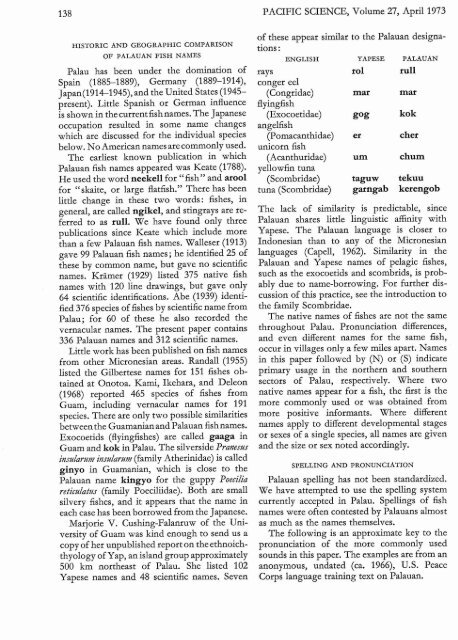Palauan Fish NamesI - ScholarSpace - University of Hawaii
Palauan Fish NamesI - ScholarSpace - University of Hawaii
Palauan Fish NamesI - ScholarSpace - University of Hawaii
You also want an ePaper? Increase the reach of your titles
YUMPU automatically turns print PDFs into web optimized ePapers that Google loves.
138<br />
HISTORIC AND GEOGRAPHIC COMPARISON<br />
OF PALAUAN FISH NAMES<br />
Palau has been under the domination <strong>of</strong><br />
Spain (1885-1889), Germany (1889-1914),<br />
Japan(1914-1945), and the United States (1945present).<br />
Little Spanish or German influence<br />
is shown in thecurrentfish names. The Japanese<br />
occupation resulted in some name changes<br />
which are discussed for the individual species<br />
below. NoAmerican names are commonly used.<br />
The earliest known publication in which<br />
<strong>Palauan</strong> fish names appeared was Keate (1788).<br />
He used the word neekell for" fish" and arool<br />
for "skaite, or large flatfish." There has been<br />
little change in these two words: fishes, in<br />
general, are called ngikel, and stingrays are referred<br />
to as rull. We have found only three<br />
publications since Keate which include more<br />
than a few <strong>Palauan</strong> fish names. Walleser (1913)<br />
gave 99 <strong>Palauan</strong> fish names; he identified 25 <strong>of</strong><br />
these by common name, but gave no scientific<br />
names. Kramer (1929) listed 375 native fish<br />
names with 120 line drawings, but gave only<br />
64 scientific identifications. Abe (1939) identified<br />
376 species <strong>of</strong>fishes by scientific name from<br />
Palau; for 60 <strong>of</strong> these he also recorded the<br />
vernacular names. The present paper contains<br />
336 <strong>Palauan</strong> names and 312 scientific names.<br />
Little work has been published on fish names<br />
from other Micronesian areas. Randall (1955)<br />
listed the Gilbertese names for 151 fishes obtained<br />
at Onotoa. Kami, Ikehara, and Deleon<br />
(1968) reported 465 species <strong>of</strong> fishes from<br />
Guam, including vernacular names for 191<br />
species. There are only two possible similarities<br />
betweenthe Guamanianand <strong>Palauan</strong> fish names.<br />
Exocoetids (flyingfishes) are called gaaga in<br />
Guam and kok in Palau. The silverside Pranesus<br />
insularum insularum (family Atherinidae) is called<br />
ginyo in Guamanian, which is close to the<br />
<strong>Palauan</strong> name kingyo for the guppy Poecilia<br />
reticulatus (family Poeciliidae). Both are small<br />
silvery fishes, and it appears that the name in<br />
each case has been borrowed from the Japanese.<br />
Marjorie V. Cushing-Falanruw <strong>of</strong> the <strong>University</strong><br />
<strong>of</strong> Guam was kind enough to send us a<br />
copy<strong>of</strong> her unpublished reporton theethnoichthyology<br />
<strong>of</strong>Yap, an island group approximately<br />
500 km northeast <strong>of</strong> Palau. She listed 102<br />
Yapese names and 48 scientific names. Seven<br />
PACIFIC SCIENCE, Volume 27, April 1973<br />
<strong>of</strong> these appear similar to the <strong>Palauan</strong> designations:<br />
ENGLISH YAPESE PALAUAN<br />
rays rol rull<br />
conger eel<br />
(Congridae) mar mar<br />
flyingfish<br />
(Exocoetidae) gog kok<br />
angelfish<br />
(Pomacanthidae) er cher<br />
unicorn fish<br />
(Acanthuridae) urn chum<br />
yellowfin tuna<br />
(Scombridae) taguw tekuu<br />
tuna (Scombridae) garngab kerengob<br />
The lack <strong>of</strong> similarity is predictable, since<br />
<strong>Palauan</strong> shares little linguistic affinity with<br />
Yapese. The <strong>Palauan</strong> language is closer to<br />
Indonesian than to any <strong>of</strong> the Micronesian<br />
languages (Capell, 1962). Similarity in the<br />
<strong>Palauan</strong> and Yapese names <strong>of</strong> pelagic fishes,<br />
such as the exocoetids and scombrids, is probably<br />
due to name-borrowing. For further discussion<br />
<strong>of</strong> this practice, see the introduction to<br />
the family Scombridae.<br />
The native names <strong>of</strong> fishes are not the same<br />
throughout Palau. Pronunciation differences,<br />
and even different names for the same fish,<br />
occur in villages only a few miles apart. Names<br />
in this paper followed by (N) or (S) indicate<br />
primary usage in the northern and southern<br />
sectors <strong>of</strong> Palau, respectively. Where two<br />
native names appear for a fish, the first is the<br />
more commonly used or was obtained from<br />
more positive informants. Where different<br />
names apply to different developmental stages<br />
or sexes <strong>of</strong> a single species, all names are given<br />
and the size or sex noted accordingly.<br />
SPELLING AND PRONUNCIATION<br />
<strong>Palauan</strong> spelling has not been standardized.<br />
We have attempted to use the spelling system<br />
currently accepted in Palau. Spellings <strong>of</strong> fish<br />
names were <strong>of</strong>ten contested by <strong>Palauan</strong>s almost<br />
as much as the names themselves.<br />
The following is an approximate key to the<br />
pronunciation <strong>of</strong> the more commonly used<br />
sounds in this paper. The examples are from an<br />
anonymous, undated (ca. 1966), U.S. Peace<br />
Corps language training text on <strong>Palauan</strong>.
















